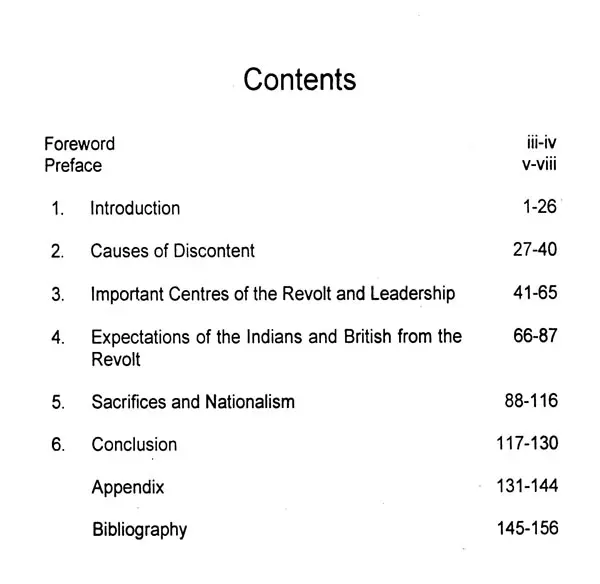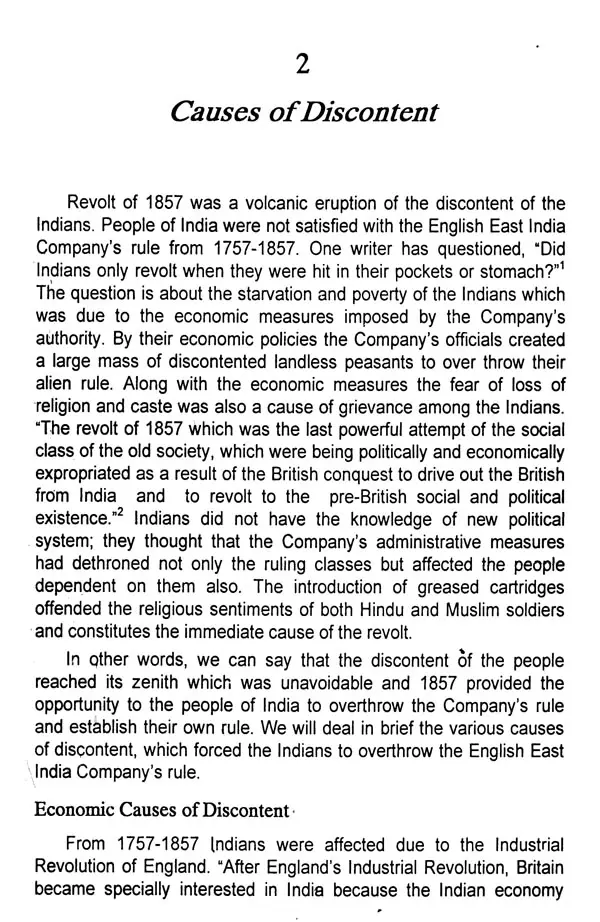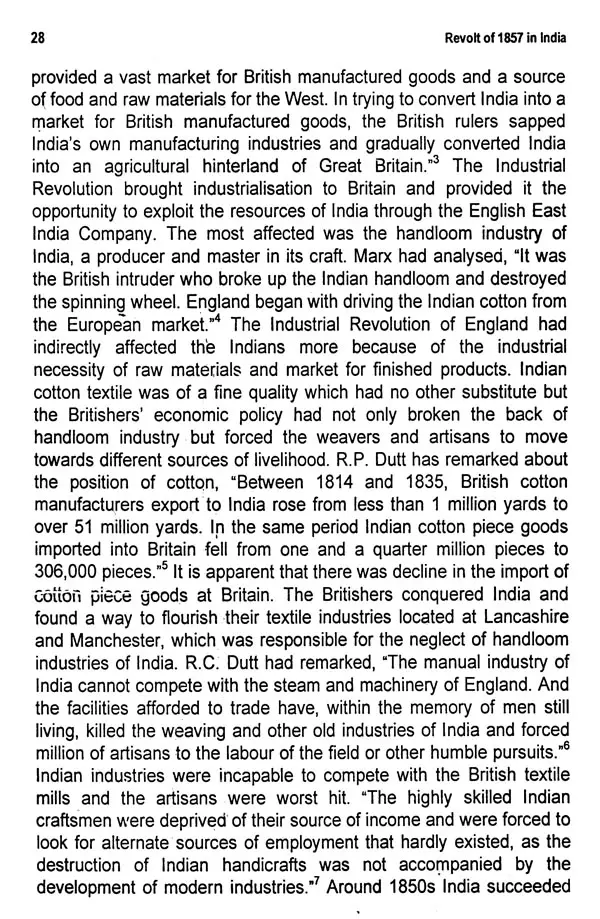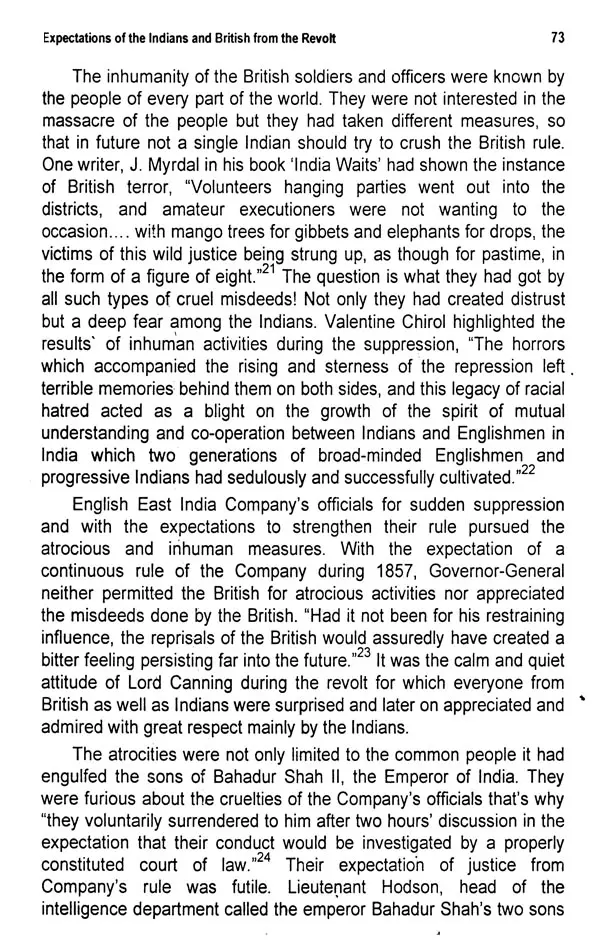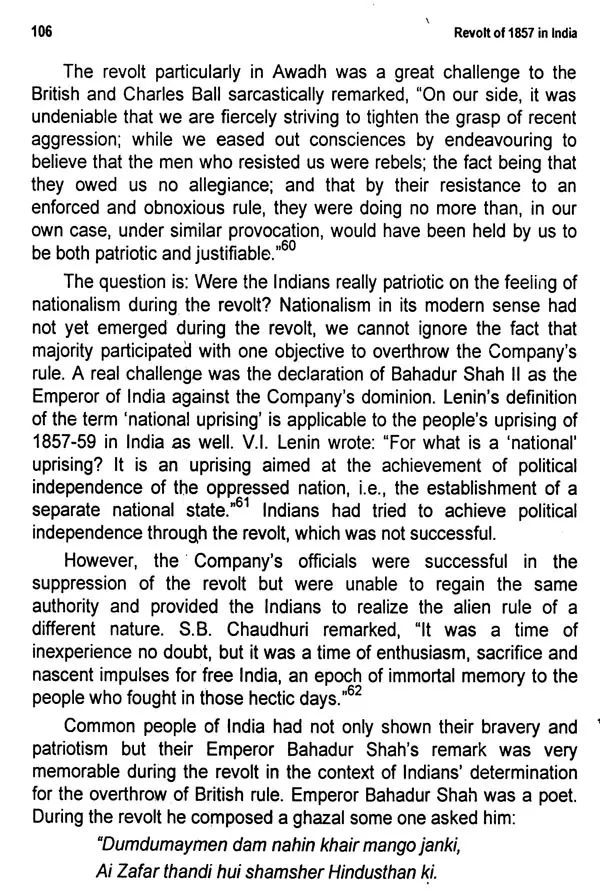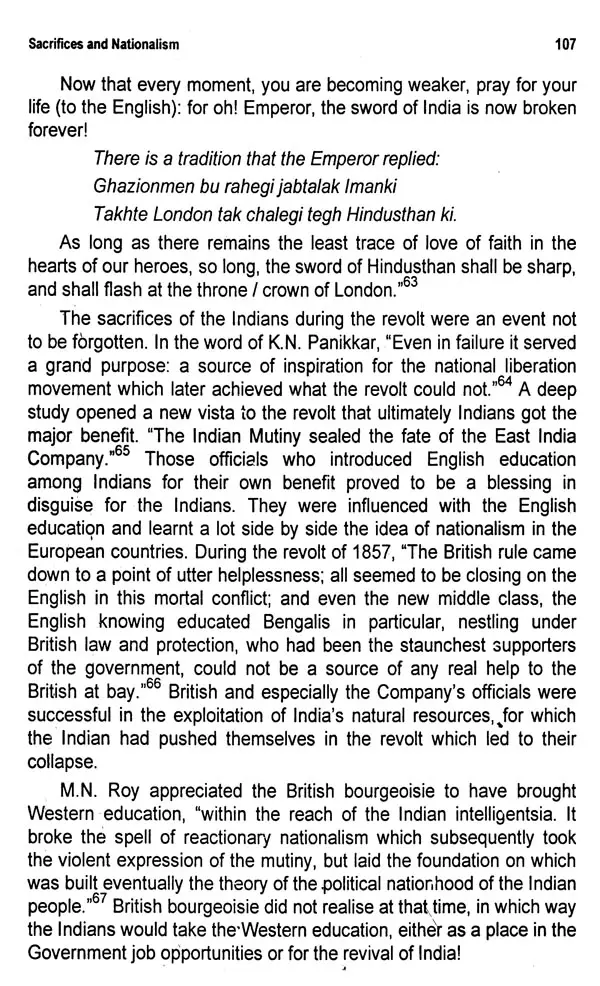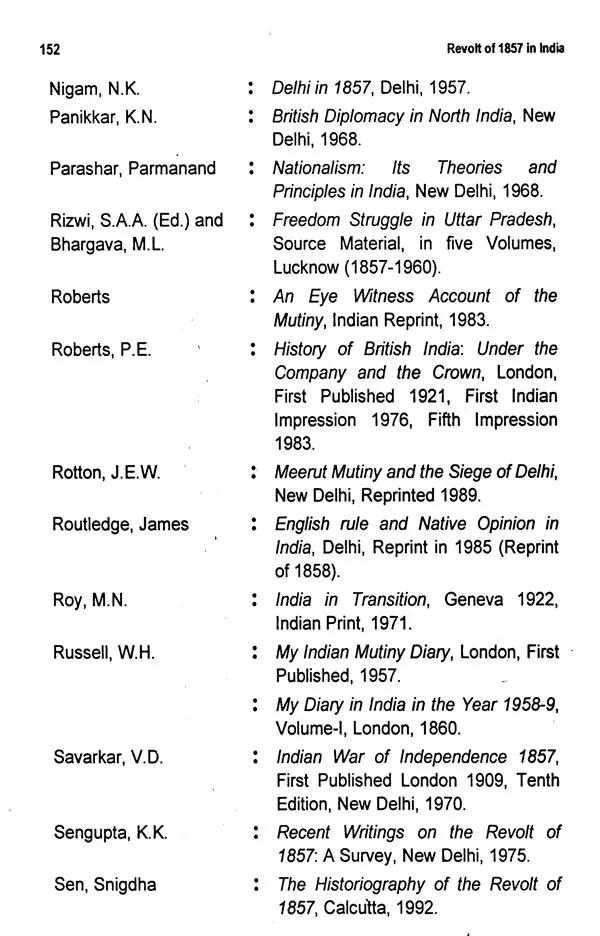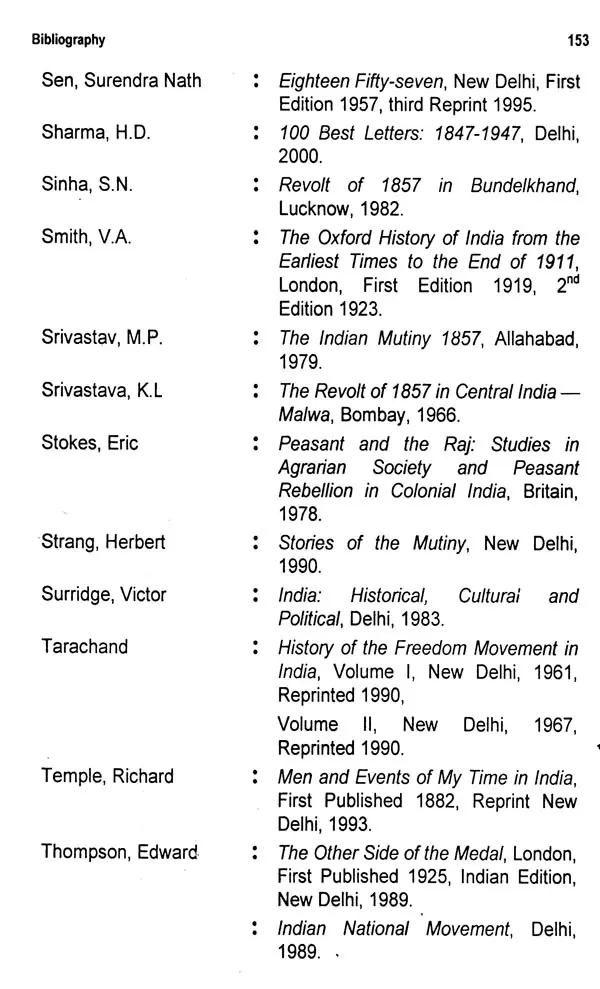
Revolt of 1857 in India
Book Specification
| Item Code: | UAG010 |
| Author: | Sunita Kumari |
| Publisher: | Literary Circle, Jaipur |
| Language: | English |
| Edition: | 2011 |
| ISBN: | 8181820606 |
| Pages: | 164 |
| Cover: | HARDCOVER |
| Other Details | 9.00 X 6.00 inch |
| Weight | 340 gm |
Book Description
W.H'.Russell in his Diary vividly described the brutality committed by Britishers on Indian masses in the Hindi heartland', " ... sewing Mohammedans in pig skins, smearing them with pork fat before executing and burning their bodies, and forcing Hindus to defile themselves .. " In the 19th Century, a number of books were written by Britishers and other foreign authors. So far as Indian historiography is concerned when V.D. Savarkar described it as a War of Independence, it gave a new dimension to this discourse. After India's independence when its centenary was being celebrated, the Indians were remembering events in Independent India. The Government of India appointed a Committee in 1957 to rewrite the history. of Revolt of 1857, as Indians was writing history of a free nation. In 2007-08, a number of books have been published and seminars have been organized o~ the events of 1857 to propagate Hindu-Muslim unity. Now, almost everybody has agreed that the Revolt of 1857 was a revolt against their colonial masters as Indians were fed up with their exploitation... It certainly started as a mutiny of the sepoys but soon after turned into a revolt of the people on a large scale, unexpected by the British masters.
Dr. Sunita has discussed different aspects of the revolt, she has consulted vernacular literature and has used folk songs of Hindi speaking region especially Bhojpuri, also to assess the impact of revolt on rural masses, as how did Kunwar Singh become the hero at the age of 80 and enthused the people of the region to sacrifice oneself for the motherland. I am confident; Dr. Sunita's work will be an important addition to the literature available on the events of 1857.
Majority of the British historians has called the revolt as 'mutiny' . because of the active participation and configuration started by the sepoys. Most of the Indian historians have called the event as the 'War of Independence' except R.C. Majumdar who called the event ,as the 'sepoy mutiny'. I consider the event as the 'Revolt' by the , people of India who had economic grievances from the Company's rule. It was the revolt 'in which different sections of society . participated with the objective to overthrow the Company's rule.
The purpose of the present study is to highlight the fact that there was economic discontent among the different sections of the Indian society, which Was responsible for the volcanic eruption of the revolt. From 1757-1857 the economic policies of the Company's officials was to gain maximum amount of profit and to establish the British supremacy on India. Company's officials had never given priority to the welfare of the Indians.
Throughout the present study my basic approach is to emphasize the economic grievances among the Indians, which was the major cause of the revolt. Another important point is the method used by the Company's military officials for the suppression of the revolt. The emphasis will also be on the contributory factors, which were responsible for the, birth of nationalism in India which emerged with the end of the revolt and the sacrifices made by the Indians remained an inspiration for the future.
The entire work has been divided into six chapters. Introduction, the first chapter provides in brief the historical writings by the British historians like Charles Bell, J.W. Kaye, G.B. Malleson, G.w. Forrest, VA Smith, Philip Mason, etc. who have defined the event as 'mutiny'. The non-British Europeans like Karl Marx, J. Myrdal and Nikolai Dobrolyubov emphasized the event as the national uprising by the Indians.
Majority of the Indians called the event as the 'War of Independence' like V.D. Savarkar, S.N. Sen, P.C. Joshi, etc. R.C. Majumdar called it as sepoy mutiny and the revolt of 1857. Second chapter deals with the causes of discontent, which were responsible for the revolt. Majority of the historians has emphasized the greased cartridges as the main cause of the revolt. The introduction of greased cartridges was the immediate cause of the revolt not theinajor cause. It was the economic discontent, which engulfed the deferent sections of the Indian society and with the outburst of the revolt, these people participated in the overthrow of the British rule.
In the third chapter, I have discussed the main centers of the revolt and its leadership. The storming centers of the revolt like Meerut, Delhi, Awadh, Allahabad, Agra, Rohilkhand, Bundelkhand and Western Bihar had their own importance and characteristics during the revolt and its widespread nature influenced the neighboring regions also. Every mass movement needs leadership. , During the revolt the leaders were Bahadur Shah II, Rani Lakshmibai, Nana Saheb, Tantiya Tope and Kunwar Singh. These leaders courageously and with great enthusiasm participated and gave their support to the people during the turmoil of the revolt.
The Industrial Revolution in England in 1750 created the need of raw materials for their industries and market for finished goods. India, a prosperous colony of Britain, was the best source for their industrial development, the thirst of industrial demands led to economic exploitation of India, which created economic discontent. From 1850s however there was the emergence of industrialization as well as the development of railways and telegraph, but in India it was too late. The revolt had only shown the company's administrative measures and the dissonant among the Indians as well as the determination to overthrow the Company's rule. Some important centers like Meerut, Delhi, and Luck now, Allahabad, Agra and pockets located in Bundelkhand Rohilkhand and western Bihar with their leaders emerged as the storming places.
It was the widespread nature of the revolt and the conflagration started by the sepoys who awakened the Company's officials, which was described by some Indian historians as the 'First War of Independence.' Before describing it, I will review the important historical works of British, non-British and Indian historians to decide as to what was the nature of this revolt. British historians like Charles Ball, G.W. Forrest, and J..W. Kaye, G.B. Malleson and C.T. Metcalfe used the term 'Mutiny' to describe the events of 1857. We have the historical works of non-British such as Karl Marx and Nikolai Dobrolyubov. They found a nationalist tinge in the events of 1857. Indian historians have also published their works with different approaches. From 1859 we have the historical works by Smashup Chandra Mukherjee's The Mutinies and the People' (1859), Sir Syed Ahmed Khan's 'An Essay on the Causes of the Indian Revolt' (1860), 'Two Native Narratives of the Mutiny in Delhi' (1898) by Mainodin Hasan Khan and Jiwan Lall. The great revolutionary V.D. Savarkar has described it as The Indian War of Independence 1857' (1909), R.C. Majumdar called it The Sepoy Mutiny and the Revolt of 1857' (1957), whereas others like S.N. Sen and P.C. Joshi have tried to prove it as the 'First War of Independence'. Both of them published their works in 1957. S.B. Chaudhuri called it 'Civil Rebellion'.
Book's Contents and Sample Pages
